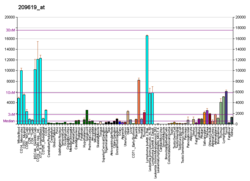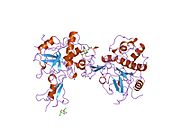CD74
HLA class II histocompatibility antigen gamma chainalso known asHLA-DR antigens-associated invariant chainorCD74(Cluster ofDifferentiation 74), is aproteinthat in humans is encoded by theCD74gene.[5][6]Theinvariant chain(AbbreviatedIi) is apolypeptidewhich plays a critical role inantigen presentation.It is involved in the formation and transport ofMHC class IIpeptide complexes for the generation ofCD4+ T cellresponses.[7][8]The cell surface form of the invariant chain is known as CD74. CD74 is acell surface receptorfor the cytokinemacrophage migration inhibitory factor(MIF).[9]
Function
[edit]The nascentMHCclass II protein in therough endoplasmic reticulum(RER) binds a segment of the invariant chain (Ii; a trimer) in order to shape the peptide-binding groove and prevent the formation of a closed conformation.
The invariant chain also facilitates the export of MHC class II from the RER in a vesicle. The signal for endosomal targeting resides in the cytoplasmic tail of the invariant chain. This fuses with a lateendosomecontaining the endocytosed antigen proteins (from the exogenous pathway). Binding to Ii ensures that no antigen peptides from the endogenous pathway meant forMHC class Imolecules accidentally bind to the groove of MHC class II molecules.[10]The Ii is then cleaved bycathepsin S(cathepsin Lincortical thymic epithelial cells), leaving only a small fragment calledCLIPremaining bound to the groove of MHC class II molecules. The rest of the Ii is degraded.[10]CLIP blocks peptide-binding untilHLA-DMinteracts with MHC II, releasing CLIP and allowing other peptides to bind. In some cases, CLIP dissociates without any further molecular interactions, but in other cases the binding to the MHC is more stable.[11]
The stable MHC class II + antigen complex is thenpresentedon the cell surface. Without CLIP, MHC class II aggregates disassemble and/or denature in the endosomes, and proper antigen presentation is impaired.[12]
Clinical significance
[edit]Vaccine adjuvant
[edit]The Ii molecule—fused with aviral vectorto aconserved regionof theHepatitis C virus(HCV) genome—has been tested as anadjuvantfor aHCV vaccinein a cohort of 17 healthy human volunteers. This experimental vaccine was well-tolerated, and those who received the adjuvanted vaccine had stronger anti-HCV immune responses (enhanced magnitude, breadth and proliferative capacity of anti-HCV-specific T-cells) compared with volunteers who received the vaccine that lacked the Ii adjuvant.[13]
The Ii molecule might also prove to be useful as an adjuvant for a futurevaccine for the SARS-CoV-2 virus,if this enhancing effect can be demonstrated to apply to the appropriate antigen(s).[14]
Cancer
[edit]Found on a number of cancer cell types. Possible cancer therapy target. Seemilatuzumab.
Axial spondyloarthritis
[edit]Autoantibodiesagainst CD74 have been identified as promisingbiomarkersin the early diagnosis of theautoimmune diseasecalledaxial spondyloarthritis(non-radiographic axial spondyloarthritisandradiographic axial spondyloarthritis/Ankylosing spondylitis).[15]
Interactions
[edit]CD74 receptorinteractswith the cytokineMacrophage migration inhibitory factor(MIF) to mediate some of its functions.[16][17][18][19][20][21]
Recovery functions
[edit]
CD74 receptor is expressed on the surface of different cell types. Interaction between MIF cytokine and its cell membrane receptor CD74 activates pro-survival and proliferative pathways that protect against injury and promote healing in different parts of the body.[22]
History
[edit]The invariant chain was first described by Patricia P. Jones, Donal B. Murphy, Derek Hewgill, andHugh McDevittat Stanford.[23]The nomenclature "Ii" comes from an Ix-based naming system (IforImmune) that predates the naming of theMajor Histocompatibility Complex.
See also
[edit]- Cluster of differentiation
- Milatuzumabthe first Mab to target CD74
References
[edit]- ^abcGRCh38: Ensembl release 89: ENSG00000019582–Ensembl,May 2017
- ^abcGRCm38: Ensembl release 89: ENSMUSG00000024610–Ensembl,May 2017
- ^"Human PubMed Reference:".National Center for Biotechnology Information, U.S. National Library of Medicine.
- ^"Mouse PubMed Reference:".National Center for Biotechnology Information, U.S. National Library of Medicine.
- ^Claesson L, Larhammar D, Rask L, Peterson PA (December 1983)."cDNA clone for the human invariant gamma chain of class II histocompatibility antigens and its implications for the protein structure".Proceedings of the National Academy of Sciences of the United States of America.80(24): 7395–7399.Bibcode:1983PNAS...80.7395C.doi:10.1073/pnas.80.24.7395.PMC389957.PMID6324166.
- ^Kudo J, Chao LY, Narni F, Saunders GF (December 1985)."Structure of the human gene encoding the invariant gamma-chain of class II histocompatibility antigens".Nucleic Acids Research.13(24): 8827–8841.doi:10.1093/nar/13.24.8827.PMC318954.PMID3001652.
- ^"UniProtKB - P04233 (HG2A_HUMAN)".The UniProt Knowledgebase.The UniProt Consortium. 2020.RetrievedAug 10,2020.
- ^Cresswell P (1994). "Assembly, transport, and function of MHC class II molecules".Annual Review of Immunology.12:259–293.doi:10.1146/annurev.iy.12.040194.001355.PMID8011283.
- ^Farr L, Ghosh S, Moonah S (2020)."Role of MIF Cytokine/CD74 Receptor Pathway in Protecting Against Injury and Promoting Repair".Frontiers in Immunology.11:1273.doi:10.3389/fimmu.2020.01273.PMC7325688.PMID32655566.
- ^abOwen JA, Punt J, Stranford SA, Jones PP, Kuby J (2013).Kuby immunology(7th ed.). New York: W.H. Freeman.ISBN978-1-4641-1991-0.OCLC820117219.
- ^Schulze MS, Wucherpfennig KW (February 2012)."The mechanism of HLA-DM induced peptide exchange in the MHC class II antigen presentation pathway".Current Opinion in Immunology.24(1): 105–111.doi:10.1016/j.coi.2011.11.004.PMC3288754.PMID22138314.
- ^Vogt AB, Kropshofer H (April 1999). "HLA-DM - an endosomal and lysosomal chaperone for the immune system".Trends in Biochemical Sciences.24(4): 150–154.doi:10.1016/s0968-0004(99)01364-x.PMID10322421.
- ^Esposito I, Cicconi P, D'Alise AM, Brown A, Esposito M, Swadling L, et al. (June 2020)."MHC class II invariant chain-adjuvanted viral vectored vaccines enhances T cell responses in humans".Science Translational Medicine.12(548): eaaz7715.doi:10.1126/scitranslmed.aaz7715.PMC7610808.PMID32554708.S2CID219722045.
- ^Larkin M (June 24, 2020)."Adjuvanted viral-vectored vaccine promising against hepatitis C in early trial".Reuters Health News.GI Health Foundation.RetrievedAug 10,2020.
- ^Baerlecken NT, Nothdorft S, Stummvoll GH, Sieper J, Rudwaleit M, Reuter S, et al. (June 2014). "Autoantibodies against CD74 in spondyloarthritis".Annals of the Rheumatic Diseases.73(6): 1211–1214.doi:10.1136/annrheumdis-2012-202208.PMID23687263.S2CID22939188.
- ^Ghosh S, Padalia J, Ngobeni R, Abendroth J, Farr L, Shirley DA, et al. (March 2020)."Targeting Parasite-Produced Macrophage Migration Inhibitory Factor as an Antivirulence Strategy With Antibiotic-Antibody Combination to Reduce Tissue Damage".The Journal of Infectious Diseases.221(7): 1185–1193.doi:10.1093/infdis/jiz579.PMC7325720.PMID31677380.
- ^ Shan ZX, Lin QX, Deng CY, Tan HH, Kuang SJ, Xiao DZ, et al. (December 2009). "[Identification of the interactions between the truncated fragments of macrophage migration inhibitory factor and CD74 using a yeast two-hybrid system]".Nan Fang Yi Ke da Xue Xue Bao = Journal of Southern Medical University(in Chinese).29(12): 2383–6, 2390.PMID20034881.
- ^Wang F, Shen X, Guo X, Peng Y, Liu Y, Xu S, Yang J (February 2010). "Spinal macrophage migration inhibitory factor contributes to the pathogenesis of inflammatory hyperalgesia in rats".Pain.148(2): 275–283.doi:10.1016/j.pain.2009.11.011.PMID20005040.S2CID38141283.
- ^Dobson SE, Augustijn KD, Brannigan JA, Schnick C, Janse CJ, Dodson EJ, et al. (December 2009)."The crystal structures of macrophage migration inhibitory factor from Plasmodium falciparum and Plasmodium berghei".Protein Science.18(12): 2578–2591.doi:10.1002/pro.263.PMC2798171.PMID19827093.
- ^Piette C, Deprez M, Roger T, Noël A, Foidart JM, Munaut C (November 2009)."The dexamethasone-induced inhibition of proliferation, migration, and invasion in glioma cell lines is antagonized by macrophage migration inhibitory factor (MIF) and can be enhanced by specific MIF inhibitors".The Journal of Biological Chemistry.284(47): 32483–32492.doi:10.1074/jbc.M109.014589.PMC2781663.PMID19759012.
- ^Verjans E, Noetzel E, Bektas N, Schütz AK, Lue H, Lennartz B, et al. (July 2009)."Dual role of macrophage migration inhibitory factor (MIF) in human breast cancer".BMC Cancer.9:230.doi:10.1186/1471-2407-9-230.PMC2716369.PMID19602265.
- ^Farr L, Ghosh S, Moonah S (2020)."Role of MIF Cytokine/CD74 Receptor Pathway in Protecting Against Injury and Promoting Repair".Frontiers in Immunology.11:1273.doi:10.3389/fimmu.2020.01273.PMC7325688.PMID32655566.
- ^Jones PP, Murphy DB, Hewgill D, McDevitt HO (January 1979). "Detection of a common polypeptide chain in I--A and I--E sub-region immunoprecipitates".Molecular Immunology.16(1): 51–60.doi:10.1016/0161-5890(79)90027-0.PMID376435.
Further reading
[edit]- Stove V, Verhasselt B (January 2006). "Modelling thymic HIV-1 Nef effects".Current HIV Research.4(1): 57–64.doi:10.2174/157016206775197583.PMID16454711.
- Riberdy JM, Newcomb JR, Surman MJ, Barbosa JA, Cresswell P (December 1992). "HLA-DR molecules from an antigen-processing mutant cell line are associated with invariant chain peptides".Nature.360(6403): 474–477.Bibcode:1992Natur.360..474R.doi:10.1038/360474a0.PMID1448172.S2CID4338656.
- Bakke O, Dobberstein B (November 1990)."MHC class II-associated invariant chain contains a sorting signal for endosomal compartments"(PDF).Cell.63(4): 707–716.doi:10.1016/0092-8674(90)90137-4.PMID2121367.S2CID19993336.
- Marks MS, Blum JS, Cresswell P (September 1990)."Invariant chain trimers are sequestered in the rough endoplasmic reticulum in the absence of association with HLA class II antigens".The Journal of Cell Biology.111(3): 839–855.doi:10.1083/jcb.111.3.839.PMC2116304.PMID2391366.
- Spiro RC, Quaranta V (October 1989)."The invariant chain is a phosphorylated subunit of class II molecules".Journal of Immunology.143(8): 2589–2594.doi:10.4049/jimmunol.143.8.2589.PMID2507633.S2CID6755576.
- O'Sullivan DM, Noonan D, Quaranta V (August 1987)."Four Ia invariant chain forms derive from a single gene by alternate splicing and alternate initiation of transcription/translation".The Journal of Experimental Medicine.166(2): 444–460.doi:10.1084/jem.166.2.444.PMC2189580.PMID3036998.
- Genuardi M, Saunders GF (1988). "Localization of the HLA class II-associated invariant chain gene to human chromosome band 5q32".Immunogenetics.28(1): 53–56.doi:10.1007/BF00372530.PMID3132422.S2CID2418453.
- O'Sullivan DM, Larhammar D, Wilson MC, Peterson PA, Quaranta V (June 1986)."Structure of the human Ia-associated invariant (gamma)-chain gene: identification of 5' sequences shared with major histocompatibility complex class II genes".Proceedings of the National Academy of Sciences of the United States of America.83(12): 4484–4488.Bibcode:1986PNAS...83.4484O.doi:10.1073/pnas.83.12.4484.PMC323758.PMID3459184.
- Koch N, Hämmerling GJ (October 1985). "Ia-associated invariant chain is fatty acylated before addition of sialic acid".Biochemistry.24(22): 6185–6190.doi:10.1021/bi00343a023.PMID3866610.
- Claesson L, Peterson PA (June 1983). "Association of human gamma chain with class II transplantation antigens during intracellular transport".Biochemistry.22(13): 3206–3213.doi:10.1021/bi00282a026.PMID6576808.
- Strubin M, Mach B, Long EO (April 1984)."The complete sequence of the mRNA for the HLA-DR-associated invariant chain reveals a polypeptide with an unusual transmembrane polarity".The EMBO Journal.3(4): 869–872.doi:10.1002/j.1460-2075.1984.tb01898.x.PMC557440.PMID6586420.
- Kvist S, Wiman K, Claesson L, Peterson PA, Dobberstein B (May 1982)."Membrane insertion and oligomeric assembly of HLA-DR histocompatibility antigens"(PDF).Cell.29(1): 61–69.doi:10.1016/0092-8674(82)90090-3.PMID6955026.S2CID9066996.
- Machamer CE, Cresswell P (December 1982). "Biosynthesis and glycosylation of the invariant chain associated with HLA-DR antigens".Journal of Immunology.129(6): 2564–2569.doi:10.4049/jimmunol.129.6.2564.PMID6982931.S2CID42620266.
- Ghosh P, Amaya M, Mellins E, Wiley DC (November 1995). "The structure of an intermediate in class II MHC maturation: CLIP bound to HLA-DR3".Nature.378(6556): 457–462.Bibcode:1995Natur.378..457G.doi:10.1038/378457a0.PMID7477400.S2CID4275956.
- Bijlmakers MJ, Benaroch P, Ploegh HL (August 1994)."Mapping functional regions in the lumenal domain of the class II-associated invariant chain".The Journal of Experimental Medicine.180(2): 623–629.doi:10.1084/jem.180.2.623.PMC2191624.PMID7519244.
- Brown JH, Jardetzky TS, Gorga JC, Stern LJ, Urban RG, Strominger JL, Wiley DC (July 1993). "Three-dimensional structure of the human class II histocompatibility antigen HLA-DR1".Nature.364(6432): 33–39.Bibcode:1993Natur.364...33B.doi:10.1038/364033a0.PMID8316295.S2CID4248668.
- Naujokas MF, Morin M, Anderson MS, Peterson M, Miller J (July 1993). "The chondroitin sulfate form of invariant chain can enhance stimulation of T cell responses through interaction with CD44".Cell.74(2): 257–268.doi:10.1016/0092-8674(93)90417-O.PMID8343954.S2CID10295196.
- Roche PA, Teletski CL, Stang E, Bakke O, Long EO (September 1993)."Cell surface HLA-DR-invariant chain complexes are targeted to endosomes by rapid internalization".Proceedings of the National Academy of Sciences of the United States of America.90(18): 8581–8585.Bibcode:1993PNAS...90.8581R.doi:10.1073/pnas.90.18.8581.PMC47401.PMID8397411.
External links
[edit]- CD74+protein,+humanat the U.S. National Library of MedicineMedical Subject Headings(MeSH)
- OverviewatDavidson College(student generated)
- School of CrystallographyThe Invariant Chain
- HumanCD74genome location andCD74gene details page in theUCSC Genome Browser.









